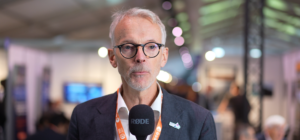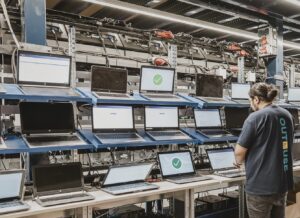13 juli 2015 -The first Innovation Radar Report reviews the innovation potential of ICT projects funded under 7th Framework Programme and the Competitiveness and Innovation Framework Programme, to demonstrate the economic impact of EU grant funding.
The SME with the highest innovation capacity in Europe is Sparsity, a 5-year old spin-off from the Polytechnic University of Catalonia, according to European Commission’s first Innovation Radar Report, published by the Joint Research Centre.
The report is based on a statistical evaluation of 10.6 per cent of ICT projects funded under Framework Programme 7 and the Competitiveness and Innovation Programme, with the aim of identifying innovations with high potential and the key innovators behind them.
The report is a first step by the Commission to proving the value of spending money on research and innovation programmes in delivering impact in terms of economic growth and job creation. This has become a political necessity since Jean-Claude Juncker took over the reins of the European Commission.
Between May 2014 and January 2015, the Commission reviewed 279 ICT projects, which had resulted in a total of 517 innovations, delivered by 544 organisations in 291 European cities. Of these, Barcelona-based Sparsity leads the top 10 SME innovators in ICT, playing a key role in developing two innovations in online graph database management.
According to the report, Barcelona is the largest innovation hub in ICT in Europe, hosting a total of 19 organisations that are key players in innovation and beating London and Paris which each host 17 such organisations. Germany, Spain and the UK are the countries with the most organisations that are key players in delivering innovations, the report says.
Top 10 SMEs and their innovations
|
Rank by ICI |
Organisation name |
Country |
City |
Project Innovation |
Nr |
Innovation Potential |
Strategic Objective |
|
4 |
SPARSITY SL |
SPAIN |
BARCELONA |
LDBC_C |
1 |
High |
12 Intelligent Information Management |
|
CoherentPaaS_B |
2 |
High |
02 Software, Services and internet connected objects |
||||
|
9 |
TRANSLATED SRL |
ITALY |
POMEZIA |
MateCat_A |
3 |
High |
11 Language Technologies |
|
10 |
GEIE ERCIM |
FRANCE |
BIOT |
WAI-ACT_A |
4 |
High |
15 ICT for Inclusion |
|
WAI-ACT_B |
5 |
High |
15 ICT for Inclusion |
||||
|
12 |
RAPITA SYSTEMS LIMITED |
UNITED KINGDOM |
YORK |
parMERASA_C |
6 |
High |
08 Embedded Systems |
|
13 |
HELIATEK GMBH |
GERMANY |
DRESDEN |
X10D_A |
7 |
High |
10 Organic and large area Electronics |
|
16 |
INVERTO NV |
BELGIUM |
EVERGEM |
E-VECTOORC_A |
8 |
High |
24 Accompanying Measures |
|
17 |
EASY GLOBALMARKET SAS |
FRANCE |
BIOT |
EAR-IT_A |
9 |
High |
01 Future Networks and Internet |
|
20 |
OPENLINK GROUP LIMITED |
UNITED KINGDOM |
CROYDON |
LOD2_A |
1 0 |
High |
12 Intelligent Information Management |
|
LDBC_A |
1 1 |
High |
12 Intelligent Information Management |
||||
|
23 |
FLUID OPERATIONS AG |
GERMANY |
WALLDORF |
Optique_B |
1 2 |
High |
12 Intelligent Information Management |
|
OpenCube_A |
1 3 |
Medium |
11 Language Technologies |
||||
|
24 |
NETWORK ENGINE FOR OBJECTS IN LUND AB |
SWEDEN |
MALMO |
LDBC_B |
1 4 |
Medium |
12 Intelligent Information Management |
|
Calculations: JRC-IPTS Data: European Commission DG Connect Note: The table presents the list and characteristics of SMEs High Capacity Innovators as defined in section 3.4 and their innovations. Innovators are defined as key organization behind the innovation according to the answers to the question 12) of the Innovation Radar Questionnaire (see Section 8.1). Total number of reviewed projects: 279. Total number of innovators: 517. Total number of innovators: 544. Review period: 20.05.2014 and 19.01.2015. |
|||||||
To provide accurate measurements, the authors devised the Innovation Capacity Indicator (ICI), which measures both the ability of the innovator company and the quality of the environment in which it operates.
The organisation with the highest ICI score is Cambridge University, directly followed by Fraunhofer Gesellschaft. The German research organisation, which has 67 institutes spread throughout Germany was identified as a key organisation in 5 per cent of all identified innovations.
Top 10 high capacity innovators and their innovations
|
Rank by ICI |
Organisation name |
Organisation type |
Country |
City |
Project Innovation |
Nr |
Innovation Potential |
|
1 |
THE CHANCELLOR, MASTERS AND SCHOLARS OF THE UNIVERSITY OF CAMBRIDGE |
HES/REC |
UNITED KINGDOM |
CAMBRIDGE |
PARLANCE_B |
1 |
High |
|
AP@home_A |
2 |
Low |
|||||
|
2 |
FRAUNHOFER- GESELLSCHAFT ZUR FOERDERUNG DER ANGEWANDTEN FORSCHUNG E.V |
HES/REC |
GERMANY |
MUNCHEN |
SODALES_A |
3 |
High |
|
i-Tex_A |
4 |
High |
|||||
|
EAR-IT_B |
5 |
High |
|||||
|
CoLiSA.MMP_A |
6 |
Medium |
|||||
|
Verdi_A |
7 |
Medium |
|||||
|
LASHARE_A |
8 |
Medium |
|||||
|
IQmulus_B |
9 |
Medium |
|||||
|
d-LIVER_B |
10 |
Medium |
|||||
|
PASTA_B |
11 |
Medium |
|||||
|
SUPERTHEME_A |
12 |
Medium |
|||||
|
IQmulus_A |
13 |
Medium |
|||||
|
EUROPRACTICE 2013_A |
14 |
Medium |
|||||
|
REWIND_B |
15 |
Medium |
|||||
|
ML²_A |
16 |
Medium |
|||||
|
ebbits_B |
17 |
Medium |
|||||
|
Policy Compass_A |
18 |
Medium |
|||||
|
STREETLIFE_C |
19 |
Medium |
|||||
|
RASEN_B |
20 |
Medium |
|||||
|
EXA2CT_B |
21 |
Medium |
|||||
|
FutureID_B |
22 |
Medium |
|||||
|
RASEN_C |
23 |
Medium |
|||||
|
COSIVU_A |
24 |
Low |
|||||
|
COSIVU_B |
25 |
Low |
|||||
|
COSIVU_C |
26 |
Low |
|||||
|
FutureID_A |
27 |
Low |
|||||
|
3 |
SPARSITY SL |
SME |
SPAIN |
BARCELONA |
LDBC_C |
28 |
High |
|
CoherentPaaS_B |
29 |
High |
|||||
|
4 |
THE UNIVERSITY OF HERTFORDSHIRE HIGHER EDUCATION CORPORATION |
HES/REC |
UNITED KINGDOM |
HATFIELD |
ACCOMPANY_C |
30 |
Medium |
|
ACCOMPANY_A |
31 |
Medium |
|||||
|
BIOMICS_A |
32 |
Low |
|||||
|
5 |
NORDJYLLANDSTRAFIKSELSKAB |
NIL |
DENMARK |
AALBORG |
REDUCTION_A |
33 |
Medium |
|
6 |
THE UNIVERSITY OF MANCHESTER |
HES/REC |
UNITED KINGDOM |
MANCHESTER |
AXLE_B |
34 |
Medium |
|
ECO2Clouds_A |
35 |
Medium |
|||||
|
7 |
PORTBASE BV |
LARGE |
THE NETHERLANDS |
ROTTERDAM |
GET Service_A |
36 |
Medium |
|
8 |
AIT Austrian Institute of Technology GmbH |
HES/REC |
AUSTRIA |
WIEN |
SCAPE_A |
37 |
High |
|
OrPHEuS_A |
38 |
Medium |
|||||
|
EPiCS_B |
39 |
Low |
|||||
|
9 |
TRANSLATED SRL |
SME |
ITALY |
POMEZIA |
MateCat_A |
40 |
High |
|
10 |
GEIE ERCIM |
SME |
FRANCE |
BIOT |
WAI-ACT_A |
41 |
High |
|
WAI-ACT_B |
42 |
High |
|||||
|
Calculations: JRC-IPTS Data: European Commission DG Connect Note: The table presents the list and characteristics of High Capacity Innovators as defined in section 3.4 and their innovations. Innovators are defined as key organization behind the innovation according to the answers to the question 12) of the Innovation Radar Questionnaire (see Section 8.1). Organization types: HES/REC (High Education and Schools and Research Centres); PUB (Public Bodies); SMEs (Small Medium Enterprise); LARGE (Large companies), NIL (Other organisations). Total number of reviewed projects: 279. Total number of innovators: 517. Total number of innovators: 544. Review period: 20.05.2014 and 19.01.2015. |
|||||||
Key findings of the report
- Most of the identified innovations are related to data processing or software development, only a few involve hardware development.
- 63 per cent of high potential innovations belong to projects that are in their final stages. Thus, new ideas and technologies that are developed during EU-financed projects mature and increase their potential as projects advance.
- Nearly 70 per cent of all innovations are brought to the market within two years.
- Commercial exploitation is planned for over 61 per cent of all innovations and all high potential innovations. Only 10 per cent of all innovations are already being exploited.
- 55 per cent of the innovations developed or being exploited are either new products or significantly improved products. However, 25 per cent of the already mature innovations are not being exploited yet, including 50 per cent of the high potential innovations.
- The ownership of innovations is dispersed and 61 per cent of innovations have multiple owners.
- A business plan is on the agenda of only 27 of the projects that plan innovation commercialisation.
- Between 25 and 30 per cent of the projects do not plan to seek capital or public investment.
The report is available at the Commission’s website.
Bron: www.sciencebusiness.net



